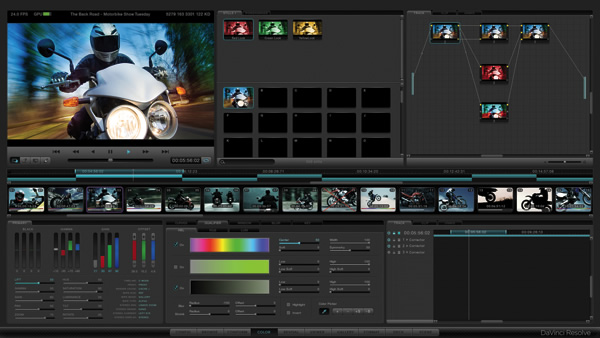Last February 4 and 5 took place the color correction workshop with DaVinci organized by 709 Media Room. The duration of the course was twelve hours and the teacher, Jorge “Yoyi” Antonio Molina, made sure that we could make the most of it.
 After a brief presentation to know where each one of us came from and what we were doing, a short introduction to each of the windows was made to have the first contact with the program.
After a brief presentation to know where each one of us came from and what we were doing, a short introduction to each of the windows was made to have the first contact with the program.
Every colorist has his or her own habits and habits when working, so depending on the settings you make in the Configuration window you can adapt DaVinci to your work system. Although this was a topic on which we spent a lot of time, there was not enough time to go through each and every one of the preferences, so “Yoyi” explained the ones he considered most important and used the most, giving advice on how to program them.
 Another of the most interesting parts of the course was when we got to the conforming phase, something that seems very simple but when the moment of truth generates problems. To understand the process we went into the editing systems (Avid and Final Cut) and generated some quicktimes with their respective EDL, XML, AAF, etc. Then we imported them into DaVinci and we were able to check what these problems were and how they can be solved before, from the editing room, or after, from DaVinci itself.
Another of the most interesting parts of the course was when we got to the conforming phase, something that seems very simple but when the moment of truth generates problems. To understand the process we went into the editing systems (Avid and Final Cut) and generated some quicktimes with their respective EDL, XML, AAF, etc. Then we imported them into DaVinci and we were able to check what these problems were and how they can be solved before, from the editing room, or after, from DaVinci itself.
The materials we had to practice with were diverse; such as HD in different frame rates or materials from Arri Alexa or Red Epic.
 Once we were familiar with the program, we started with color correction, starting with the system of working with nodes and the differences between each one of them. To apply them we saw how to make basic corrections, secondary corrections, masks, animation, 3D tracking, chromas, etc.
Once we were familiar with the program, we started with color correction, starting with the system of working with nodes and the differences between each one of them. To apply them we saw how to make basic corrections, secondary corrections, masks, animation, 3D tracking, chromas, etc.
Without leaving aside the personal part, the teacher gave some “tricks” on how to create certain looks or effects. In addition, although the course was aimed at gaining knowledge of the program, theoretical explanations were given (for example, students who did not know how to interpret waveforms or the vectorscope were taught how to interpret them).
Another advantage  was the fact that we were not too many students. At the end of the day on Sunday there was time to practice the acquired knowledge and “Yoyi” was able to go from table to table solving doubts and seeing what everyone was doing. It was also explained how the controller (Tangent Wave) worked, and the students were practicing with it.
was the fact that we were not too many students. At the end of the day on Sunday there was time to practice the acquired knowledge and “Yoyi” was able to go from table to table solving doubts and seeing what everyone was doing. It was also explained how the controller (Tangent Wave) worked, and the students were practicing with it.
In short, I think it has been a very complete course, with very good organization of the contents and also with very good communication between the teacher and the attendees, which gave it a more personal touch.
At the end of March the same DaVinci workshop will be held for those who could not come or did not find a place. It will have the same duration and the same teacher.

